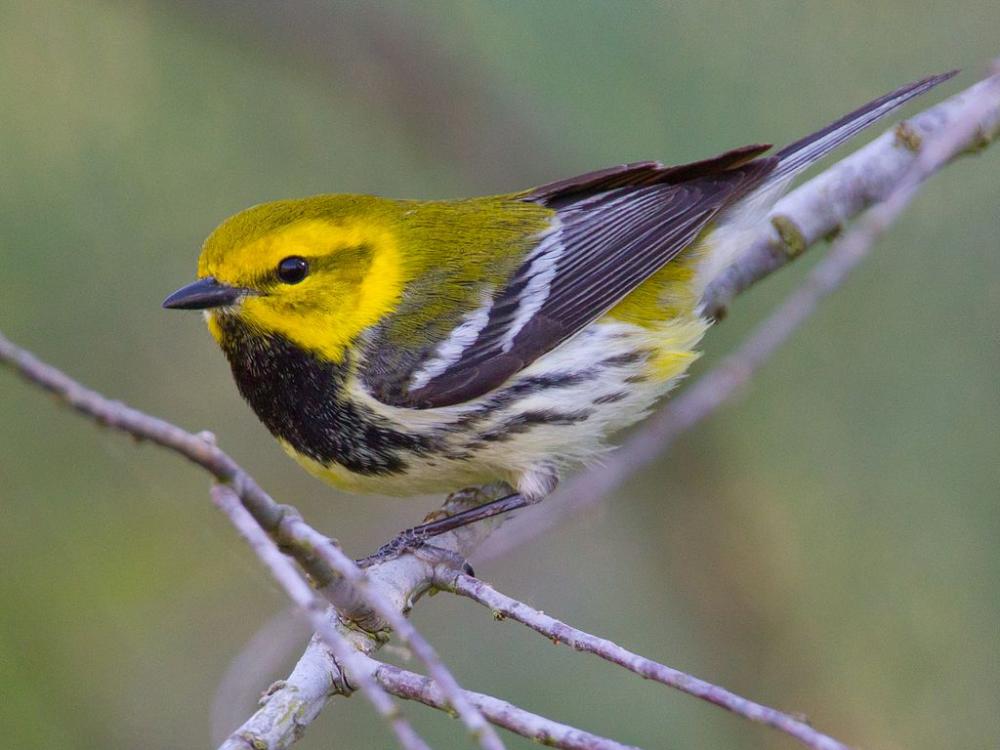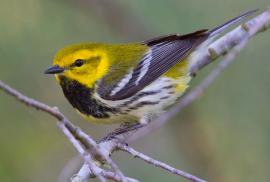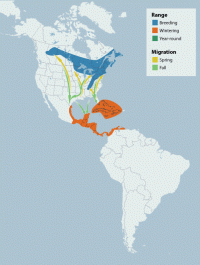Guide to Boreal Birds
This is an in-depth boreal species profile.
What is this?
This species is one of more than 30 birds selected for in-depth profiles. Find out why and see all selected boreal birds »
Overview
The diminutive Black-throated Green Warbler is one of those species jokingly referred to as having a name longer than itself! It is one of the commonest warblers in many parts of its range, and its oft-repeated songs of high-pitched zees and zoos are characteristic summer sounds of northeastern forests. It is one of the most commonly seen warblers during migration; at this season it feeds at any height above the ground, but where the trees are tall it spends most of its time among the highest branches. This bird's distinctive song is one of the easiest of warbler songs to learn. It is one of a group of four or five sister species – the others being the Golden-cheeked, Hermit, Townsend's, and possibly Black-throated Gray Warblers – comprising a superspecies that probably resulted from partitioning of ancestral breeding populations by glaciations during the late Pleistocene.
Description
5" (13 cm). Crown and upperparts olive green, throat and sides of breast black, face yellow. Female similar but duller.
Voice
Thin, buzzy, lazy zeer, zeer, zeer, zeer, zee? or faster zee-zee-zee-zoo-zee.
Nesting
4 or 5 brown-spotted white eggs in a cup of grass, moss, and plant fibers, lined with hair and feathers and placed in the branches of a conifer.
Habitat
The Black-throated Green Warbler is associated with conifers across most of its breeding range, nesting in spruce, pine, fir, cedar, or cypress stands, depending on the location, from sea level to mountaintops. It also occurs in mixed and broadleaf forests in the southern parts of the breeding range. It shows no particular affinity for conifers or any other specific vegetation type during migration, when it can be found in virtually any vegetated habitat, even scrub and adjacent herbaceous growth and grasses. It winters primarily in montane habitats, usually canopies of tall forest trees, though it sometimes occurs in scrub, gardens, and old fields.
Range/Migration
Beginning in August, Black-throated Green Warblers move south from the breeding grounds, east of the Great Plains, to the winter grounds in eastern and southern Mexico and Central America. Small numbers winter in south Florida, the Bahamas and Greater Antilles, south Texas, and northern South America. Most follow the Gulf Coast overland through Mexico but many cross the Gulf directly to southern Mexico. There appears to be some seasonal movement within the wintering grounds in response to rainfall, departing areas as the local dry season begins. In Central America, this results in a shift from the Pacific slope to the Atlantic slope around December. Spring migration begins in March and is essentially the reverse of fall migration. Most reach the breeding grounds in late April and May, though the coastal swamp subspecies arrives in late March, several weeks ahead of birds nesting due west in the mountains.
Breeding
This species' breeding range extends across the eastern and central southern boreal zone, from extreme eastern British Columbia to the Maritimes, and south through most of the Great Lakes region, New England, and the Appalachians. A few nest in pine stands in Indiana and the Ozarks. A distinct subspecies occupies cypress swamps from southeastern Virginia to northeastern South Carolina. Canada's boreal zone supports about half of the global breeding population. Females arrive several days behind the males, pair bonds are formed, and nest initiation follows. Nests are usually placed in conifers, typically where multiple, small branches meet the trunk. The female incubates the three to five (usually four) eggs for 12 days. The male's contribution to feeding the young varies, but at a minimum he gives some food to the female, who transfers it to the young. Fledging occurs 8-11 days after hatching; the young remain near the nest for several days until they can fly effectively. There is only one brood per season, and the pair bond usually breaks down shortly after fledging, with part of the brood accompanying each parent for up to a month, receiving as much food as possible by begging.
Diet/Feeding Behavior
This species' diet is typical of the genus. It eats small insects and arachnids almost exclusively on the breeding grounds, often specializing on hairless caterpillars. It capitalizes on spruce budworms during outbreaks of that species. On migration it takes some small berries, and, like other warblers, will eat cecropia tree protein corpuscles in winter. It forages primarily by gleaning from upper surfaces of leaves on small branches; it also frequently hovers to capture insects on undersides of vegetation. Its foraging behavior is more specialized in the north, where several similar species co-occur, than in the south, where it has a broader niche and will glean, hover, sally, and hawk about equally. It is a very active forager, making short flights more frequently than other warblers with which it occurs. It often joins mixed-species feeding flocks with other warblers, chickadees, and nuthatches at the end of the breeding season.
References
Blancher, P. 2003. The importance of Canada's boreal forest to landbirds. Canadian Boreal Initiative [Online].
Collins, S. L. 1983. Geographic variation in habitat structure of the Black-throated Green Warbler (Dendroica virens). Auk 100:382-389.
Morse, D. H. 1993. Black-throated Green Warbler (Dendroica virens). In The Birds of North America, No. 55 (A. Poole and F. Gill, eds.). The Academy of Natural Sciences, Philadelphia, and The American Ornithologists' Union, Washington, D.C.
Pitelka, F. A. 1940. Breeding behavior of the Black-throated Green Warbler. Wilson Bull. 52:3-18.
Rabenold, K. N. 1980. The Black-throated Green Warbler in Panama: geographic and seasonal comparison of foraging. Pp. 297-307 in Migrant birds in the Neotropics (A. Keast and E. S. Morton, Eds.). Smithson. Inst. Press, Washington, D.C.
Sauer, J. R., J. E. Hines, and J. Fallon. 2004. The North American Breeding Bird Survey, Results and Analysis 1966 - 2003. Version 2004.1. [Online]. USGS Patuxent Wildlife Research Center, Laurel, MD.
Sprunt, A., Jr. 1953. Wayne's Black-throated Green Warbler. U.S. Nat. Mus. Bull. 203:308-316.
Credits
Birding content provided by National Wildlife Federation/eNature, with support from Ducks Unlimited/The Pew Charitable Trusts.





